Table of contents
- Suspension special: rear Does the motorcycle drive strange lines? Adjust the rear section correctly!
- Specialists
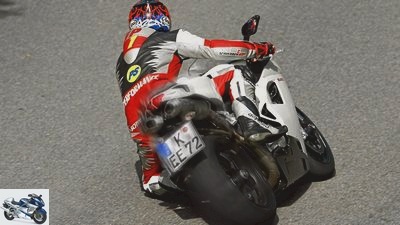
archive
accesories
landing gear & Spring elements
Suspension special: Part 7 – rear
Suspension special: rear
Does the motorcycle drive strange lines? Adjust the rear section correctly!
Content of
Does the oven coagulate, pump and run strange lines? No reason to freak out right away. Because there may be only a few movements at the rear end between frustration and pleasure.
Volkmar Jacob
10/10/2012
Richie likes to let it rip properly. To this end, he has upgraded, given his branding iron a sinfully expensive chassis. But he’s not really satisfied with it. When hunting, his baby develops a strange life of its own and skids through the arches rather than drawing a clean line. In addition, the bike tramples nastily over bumps, and the handling leaves a lot to be desired. Richie imagined it very differently. What to do?
Like our virtual friend, many sports drivers do in reality. Even the finest components only develop their potential when they are properly coordinated. We have shown step by step how to do this in the previous episodes of this suspension special. This part provides solutions to problems at the rear end that occur again and again despite (supposedly) good coordination.
Buy complete article
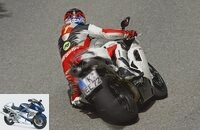
Suspension special: rear
Does the motorcycle drive strange lines? Adjust the rear section correctly!
4 pages) as PDF
€ 2.00
Buy now
Heck pumps when accelerating
If the rear section pumps, especially when accelerating strongly, this can have several causes. Obvious is an underdamped rebound stage that controls the rebound movement. If it is too slack, the rear end rebounds too quickly, which causes a lot of unrest in the chassis, especially on bad roads. In addition, a constructive factor comes into play: the anti-dive effect. This is made up of the difference in height from the rear wheel to the swing axle and the swing arm length and prevents the rear end from settling when accelerating. Sporty bikes are usually designed in such a way that the rear end lifts a little when accelerating. The combination of low rebound damping, strong acceleration over bumps and the anti-dive effect causes every rear of the vehicle to stumble. If the rebound stage damping is too soft, cornering stability, accuracy and steering precision also suffer. Solution: Close the rebound stage so far that the shock absorber needs just under a second to return to its starting position (zero position) after a long compression. The video “Shock absorber damping” on www.ps-online.de deals with this topic, among other things. There are also valuable tips for the shock absorber setup in PS 2/2012.
Further causes for a pumping tail are insufficient compression stage damping and / or a spring that is too soft or too little pretensioned. In extreme cases, this means that the monoshock compresses as far as it will go, even in curves, and can no longer absorb any shocks. The rear tire now has to do this work. He is of course overwhelmed by this, as a result, the rear begins to pump or the tire even loses its grip. If the stern settles too much, the handling also deteriorates and the machine tends to make wide lines at the exit of a curve. This can be remedied by a more strongly preloaded or harder spring (measure negative spring deflection). A more closed pressure stage also counteracts strong compression. To check, simply attach a cable tie to the damper rod and push it up before driving. An uneven road is ideal as a test track, as the shock absorber is more compressed there than on perfectly flat terrain. After driving, the cable tie should still be a few millimeters away from the stop buffer.
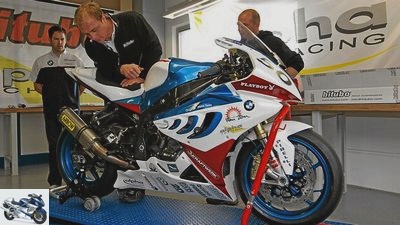
jkuenstle.de
Professionals take a systematic approach to chassis problems and find a solution for (almost) every problem.
Rear wheel stamping when braking
Sometimes the rear wheel stamps when anchoring or downshifting despite the anti-hopping clutch. Too much play on the strut mount, including the tension struts and deflection, can cause or intensify this phenomenon. Decelerating hard with the front stoppers relieves the load on the rear wheel. In this state, bumps guide unrest into the rear via the strut mount and deflection, which can increase to nasty rattling. This game can trigger insidious chattering, a high-frequency punching of the front wheel, even under load in an inclined position. These annoying vibrations can build up, especially when turning on the brakes when the hindquarters are relieved. To check the play, completely relieve the load on the rear wheel and move the swing arm up and down slightly. Two millimeters of play are already too much for an athlete. In such a case, custom-fit bearings and connections from specialists help.
Stern uncomfortable I
If the shock absorber does not sufficiently absorb bumps and appears stubborn overall, this is mostly due to a spring that is too hard or too much pretensioned. Too tight compression damping also causes this unpleasant characteristic. In addition to the responsiveness, braking stability (wheel jumps or breaks out) and wheel control (target accuracy) also suffer. In addition, a strut that is tuned too hard causes – listen and be amazed – the handlebars hit. This happens because the rear section introduces bumps from asphalt wrinkles into the entire chassis. When driving over hard edges, an insensitive rear wheel suspension offsets the wheel, which means that the steering is at an angle to the direction of travel for a fraction of a second. Already wedges the front section and puts the front structure in the dreaded torsional vibrations.
Before approaching the damping, you should always measure the negative spring deflection. This reveals a spring that is too hard or incorrectly preloaded.
Adjust the spring rate as well as the preload, soften the pressure level a little with the adjuster. In contrast to (almost) all forks, some struts offer separate adjustment options for high and low-speed damping. These terms have nothing to do with the driving speed, but with the compression speed. It is often sufficient to open the high-speed pressure stage further – usually completely on country roads. Only later gradually soften the low-speed area. If that doesn’t help, the cause may be a progression curve that is too steep. Means: The rear hardens disproportionately strong after initially good suspension behavior. This phenomenon is often the result of a different deflection kinematics, which comes from a changed rear height (example: strut length). In addition, too much mechanical resistance (friction) in the shock absorber / deflection can lead to an unruly rear end. Here we recommend going to a specialist.
Rear uncomfortable II
Analogous to the front of the vehicle (PS 5/2012), too tight rebound stage damping also leads to unrest in the chassis. The tail does not rebound quickly enough when there are several consecutive bumps and gets stuck in the hard area of the spring. As a result, the shock absorber no longer absorbs bumps and passes them on to the chassis. As with a too slack pressure stage, the rear is now too low – with the known consequences for handling and accuracy. Further effects: The bike tends to jump on bad roads, the bike rocks on bumps and even oscillates when driving straight ahead. The steering geometry also changes in the direction of unwieldy because the motorcycle is lower at the rear. In these cases adjust the rebound damping as described above.
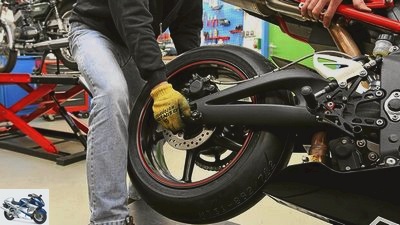
archive
Too much play in the strut mount and / or deflection can cause unrest in the chassis.
Set-up moment in curves
If the bike positions itself in bends with bumps, this is usually due to a too wide, flat tire with a low cross-section. Bumps then literally push the load back into the vertical position. The same also causes insufficient tire air pressure.
Sluggish / nervous turning in
As already described in the last part of the special, sluggish steering behavior is often the result of a geometry that is not easy to handle. If the coordination of suspension and damping fits, the rear can be raised a little using various methods: length adjustment on the strut, push rod, variable mounting point of the strut on the rear frame, shorter tension struts of the deflection, higher swing arm pivot point. However, all these changes have a direct effect on the progression curve of the deflection. Used cautiously, they usually have more advantages than disadvantages. If the bike is too wobbly at the corner entrance, simply lower the rear using one of the methods mentioned.
Specialists
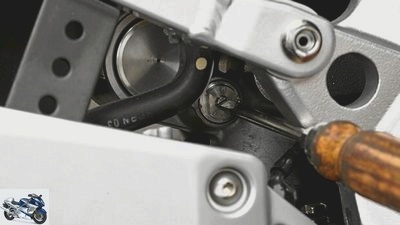
fact
The right twist: If the damping is incorrectly adjusted, changes often work wonders.
Alpha technique
83071 Stephanskirchen, Tel. 0 80 36/30 07 20 www.alphatechnik.de
Alpha Racing (BMW S 1000 RR)
83071 Stephanskirchen, Tel. 0 80 36/30 31 30 www.alpharacing.com
GMD Computrack Strassmaier
83052 Heufeld / Bruckmuhl, Tel. 0 80 61/9 36 92 20 www.strassmaier.de
HH Racetech
72108 Rottenburg, Tel. 0 74 57/94 82 90 www.hh-racetech.com
Ohlins
53520 Meuspath, Fax 0 26 91/9 37 78 90 www.ohlins.eu
Wilbers
48527 Nordhorn, Tel. 0 59 21/72 71 70 www.wilbers.de
GL Suspension Service
75391 Gechingen, Tel. 0 70 56/92 78 24 www.world-of-suspension.de
Zupine
83301 Traunreut, Tel. 0 86 69/84 80 www.zupin.de
Emil Schwarz (precision parts / bearings)
73660 Urbach, Tel. 0 71 81/99 52 90 www.emilschwarz.de
Related articles
-
Suspension special: Part 3 – Strut damping
triumph accesories landing gear & Spring elements Suspension special: Part 3 – Strut damping Suspension special: shock absorber The right set-up for the…
-
counselor technology & future Rear suspension Rear suspension Rear suspension The first motorcycles had a rigid rear suspension. Since bumps in the road…
-
Suspension special: Part 9 – Strut tuning
Jahn accesories landing gear & Spring elements Suspension special: Part 9 – Strut tuning Suspension special: strut tuning What good is the conversion of…
-
Chassis special: Part 6 – Troubleshooting the front of the vehicle
archive accesories landing gear & Spring elements Chassis special: Part 6 – Troubleshooting the front of the vehicle Suspension special: troubleshooting…
-
Chassis special part 1: motorcycle suspension
fact accesories landing gear & Spring elements Chassis special part 1: motorcycle suspension Chassis special: suspension Everything about motorcycle…
-
Suspension guide – correctly adjusting the damping, part 2
Cook counselor workshop Adjusting suspension / damping correctly, part 2 Guide: correctly adjusting the suspension / damping, part 2 A mystery for many:…
-
Honda travel transalp special part 1
Sdun to travel Honda travel transalp special part 1 Honda travel transalp special part 1 The Honda Transalp is being upgraded If nothing helps, you have…
-
Chassis special: Part 2 – fork damping
fact accesories landing gear & Spring elements Chassis special: Part 2 – fork damping Chassis special: fork damping Front wheel damping – the dream setup…
-
Suspension guide – correctly adjusting the damping, part 1
Photos: fact accesories landing gear & Spring elements Adjusting suspension / damping correctly, part 1 Guide: Adjusting the suspension / damping…
-
Suspension special: Part 8 – fork tuning
Jahn accesories landing gear & Spring elements Suspension special: Part 8 – fork tuning Suspension special: fork tuning What are the real benefits of…